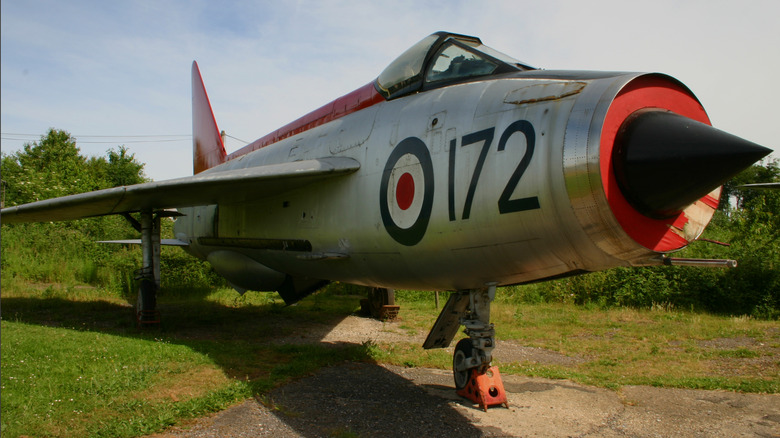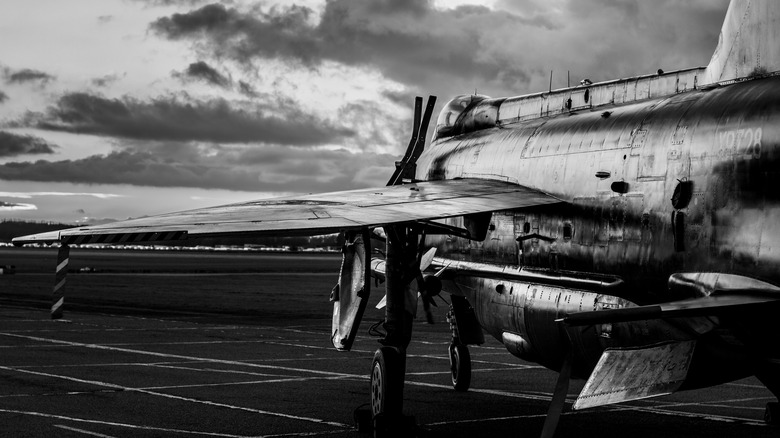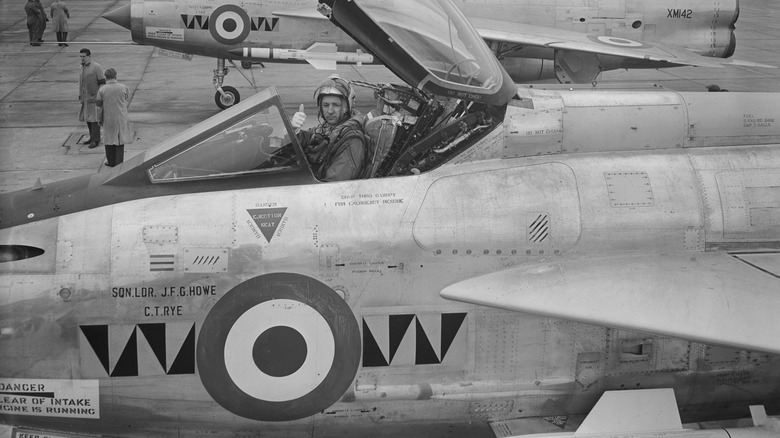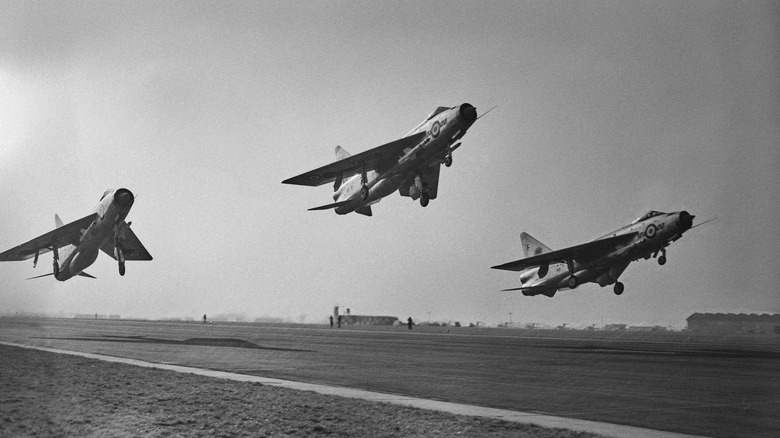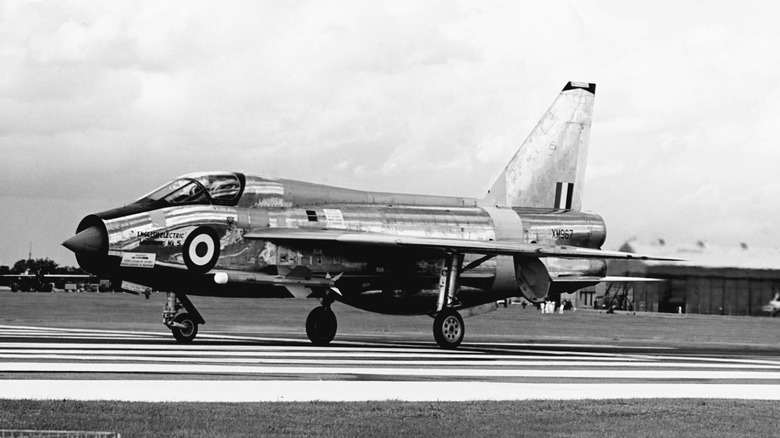Everything To Know About The English Electric Lightning Jet
The primary asset for an aircraft, of course, depends on its function. In a commercial airliner, economical running and fuel efficiency are most important, with profitability first and foremost. There's a point at which increasing speed becomes impractical, as it's more expensive to maintain such an engine. Military aircraft, meanwhile, tend to have more of a need for speed.
Interceptors won't do much intercepting if they aren't fast and maneuverable enough. At the same time, more lightly-armed aircraft generally are incredibly vulnerable to enemy fire, so evasiveness is crucial. Where supersonic airliners such as the iconic-yet-troubled Concorde haven't yet quite taken off, then, supersonic aircraft of all sorts have a long and fascinating past in military history. One often underappreciated example is the English Electric Lightning, an extraordinary jet from the Cold War era.
This fascinating aircraft deserves a much closer look. Here's a breakdown of its creation, its armaments and equipment, how it was ultimately used, and exactly why it was such a different beast from so many other jets of its time.
When and why was the English Electric Lightning created?
During the Cold War, the British, like so many other nations around the world, sensed danger brewing and responded as humanity so inevitably will — with increasingly potent weapons and military vehicles. The Avro Vulcan strategic bomber was one result of this work. Mighty as it was, the Vulcan and other British bombers were sure to be primary targets for any potential enemy that may emerge. The best defense is a good offense, they say, and so fighters/interceptors were developed that could deter any assault on the bases they called home.
This line of thinking led to the English Electric Lightning, but the aircraft took some considerable time to come to fruition. Early in 1949, English Electric recognized the potential of the concept for the aircraft, which had been devised by one W.E.W. Petter, known as Teddy. There was hope that it could achieve a top speed even higher than originally envisaged, and a lofty Mach 2 became the target to hit.
August 1954 marked the aircraft's first flight, but it wasn't until the turn of the following decade that it officially joined two squadrons of the Royal Air Force. When it did, it proved to be an impressive asset indeed, capable not only of remarkable speeds but of other spectacular mid-air feats too.
The top speed and other impressive stats of the English Electric Lightning
Further considering the subtitle "Lightning," you'd expect this English Electric creation to be quite the speedy aircraft. This certainly proved to be the case, as it was capable of reaching 1,500 miles per hour, per National Museums Scotland. At the time, the British Royal Air Force had never yet had a supersonic jet, so the Lightning was a prospect both exciting and formidable in equal measure.
In terms of range, the aircraft was not originally designed with that as a primary focus. It was not intended to be taken for long missions, but to perform optimally when close to the crucial strategic areas it was envisioned guarding. It was to respond quickly, outmaneuver potential threats, and return — rather than pursue potential threats or approach its own targets from some distance. Nonetheless, it would go on to have an operational range of approximately 850 miles, per BAE Systems.
Simply achieving such speeds in any scenario is quite a feat for an aircraft with origins in the late 1940s, but the Lightning couldn't just hit 1,500 miles per hour. In a YouTube retrospective about the Lightning, Imperial War Museums' Liam Shaw explains that it "had such a power-to-weight ratio that it could actually stand on its tail and exceed the speed of sound in a vertical climb."
At up to 45,750 pounds and almost 35 feet long, it's far from an insubstantial jet, and it packs an impressive range of powerful technology to boot.
Ravenous Rolls-Royce engines and mighty missiles
To achieve its impressive supersonic vertical climbs (surely quite the sight to behold), the F.3 Lightning was equipped with a pair of Avon 301Rs from Rolls-Royce. Earlier Lightning models boasted the 201 Avon engine, which offered 14,430 lbf of thrust with the afterburner in play (per AirVectors). These were potent powerplants, but as such an offensively-oriented aircraft, it's just as important to consider its weaponry.
To maintain the weight balance that could be so crucial to its performance, the F2.A Lightning had to take care with its armaments. Two Firestreak missiles could be kept alongside its Aden cannons or removed to make room for an additional pair of Adens. Adens were popular for their versatility (they could be installed inside or outside an aircraft in a wide arc), and a quartet of 30 mm cannons enabled the jet to pose quite the threat.
The Lightning's arsenal and other equipment would be developed and improved as different versions of the aircraft were manufactured.
How the Lightning changed over its time in service
Fortunately for the world, the Cold War didn't reach boiling point, so the attacks that the Lightning was primarily envisioned to counter never really materialized. Regardless, the Lightning family was utilized by the British Royal Air Force until its withdrawal in 1988.
Over this time, a program of continual improvement took place. This resulted in the addition of models such as 1962's Lightning F.2 (which arrived in Saudi Arabia as the F.52) and the F.3, which dramatically changed the weapons on board by removing the cannons and implementing a Red Top missile system. Both the T.4 and T.5 models later added a second seat to allow pilots to receive one-on-one training in the operation of the aircraft, and its mechanics were developed with the addition of bolstered radar (the AI-23B of the F.3 for instance) and the more aerodynamic wings of the F.6.
The Lightning, then, was a technically impressive aircraft indeed. Though its primary purpose ultimately didn't come to pass, it was an enormous step forward for British aviation in particular.
